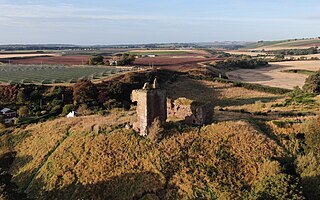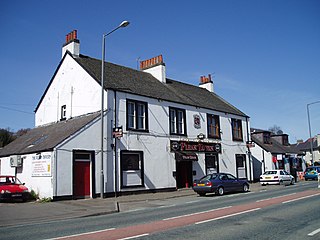
Stirling is a city in central Scotland, 26 miles (42 km) northeast of Glasgow and 37 miles (60 km) north-west of Edinburgh. The market town, surrounded by rich farmland, grew up connecting the royal citadel, the medieval old town with its merchants and tradesmen, the Old Bridge and the port. Located on the River Forth, Stirling is the administrative centre for the Stirling council area, and is traditionally the county town of Stirlingshire. Proverbially it is the strategically important "Gateway to the Highlands".

The University of Stirling (Scots: University o Stirlin, Scottish Gaelic: Oilthigh Shruighlea is a public university in Stirling, Scotland, founded by royal charter in 1967. It is located in the Central Belt of Scotland, built within the walled Airthrey Castle estate.

Stirling Castle, located in Stirling, is one of the largest and most historically and architecturally important castles in Scotland. The castle sits atop an intrusive crag, which forms part of the Stirling Sill geological formation. It is surrounded on three sides by steep cliffs, giving it a strong defensive position. Its strategic location, guarding what was, until the 1890s, the farthest downstream crossing of the River Forth, has made it an important fortification in the region from the earliest times.
Her Majesty's Inspectorate of Education (HMIe) was an executive agency of the Scottish Government, responsible for the inspection of public and private, primary and secondary schools, as well as further education colleges, community learning, Local Authority Education Departments and teacher education.
Education in Scotland is provided in state schools, private schools and by individuals through homeschooling. Mandatory education in Scotland begins for children in Primary 1 (P1) at primary school and ends in Fourth Year (S4) at secondary school. Overall accountability and control of state–education in Scotland rests with the Scottish Government, and is overseen by its executive agency, Education Scotland, with additional responsibility for nursery schools being the joint responsibility of both Education Scotland and the Care Inspectorate. Scotland's private schools are overseen by the Scottish Council of Independent Schools. Children in Scotland sit mandatory National Standardised Assessments in Primary 1 (P1), Primary 4 (P4), Primary 7 (P7) at the end of primary school, and Third Year (S3) in secondary school, which assist in monitoring children's progress and providing diagnostic data information to support teachers' professional judgement.

Alloa is a town in Clackmannanshire in the Central Lowlands of Scotland. It is on the north bank of the Forth at the spot where some say it ceases to be the River Forth and becomes the Firth of Forth. Alloa is south of the Ochil Hills, 5.5 miles (8.9 km) east of Stirling and 7.9 miles (12.7 km) north of Falkirk; by water Alloa is 25 miles (40 km) from Granton.
Sir Archibald Orr-Ewing, 1st Baronet was a Scottish Conservative Party politician.
The Scottish Social Services Council (SSSC) is a non-departmental public body and is responsible for raising standards in the country's social work, social care and children and young people's workforce.

Granton is a district in the north of Edinburgh, Scotland. Granton forms part of Edinburgh's waterfront along the Firth of Forth and is, historically, an industrial area having a large harbour. Granton is part of Edinburgh's large scale waterfront regeneration programme.

The Care Inspectorate is a scrutiny body which supports improvement. They look at the quality of care in Scotland to ensure it meets high standards. Where improvement is needed, they support services to make positive changes. The Care Inspectorate was set up in April 2011 by the Scottish Government as a single regulatory body for social work and social care services, including child protection and the integration of children's services. The new organisation took on work in these areas previously carried out by:

Red Castle of Lunan is a ruined fortified house on the coast of Angus, Scotland. It is about 4 miles (6.4 km) south-southwest of Montrose.

Bachupally is a suburb in the Medchal-Malkajgiri district of the Indian state of Telangana. It is the mandal headquarters of Bachupally mandal in Malkajgiri revenue division. It was a part of Ranga Reddy district before the re-organisation of districts in the state.
Pine Hill is a suburb, hill, and general area of the New Zealand city of Dunedin. It is sited on the hill of the same name, a spur of Mount Cargill overlooking North East Valley and Glenleith 4 kilometres (2.5 mi) to the north of the city centre. This spur lies in the fork of the confluence of the Water of Leith and its largest tributary, the Lindsay Creek. The term Pine Hill is used generally to refer to a group of suburbs which lie on the hill's slopes: Pine Hill suburb itself, which sits on the upper slopes of the spur, and also two other suburbs which lie on the lower slopes, Dalmore and Liberton.

Plean is a village, in the Stirling council area of central Scotland, located on the main A9 road from Falkirk. At the 2001 census, Plean had a population of 1,740. Plean has some historic buildings, some council houses and an estate.

Mar's Wark is a ruined building in Stirling built 1570–1572 by John Erskine, Regent of Scotland and Earl of Mar, and now in the care of Historic Scotland. Mar intended the building for the principal residence of the Erskine family in Stirling, whose chief had become hereditary keeper of the nearby royal Stirling Castle where the princes of Scotland were schooled. Wark is a Scots language word for work, and here it means building. The house is also called "Mar's Lodging."
Social care in Scotland encompasses social work; care home services in the community for adults, children and young people; and services for young children, including nurseries and after-school care clubs.

Inch House, a former country house situated within Inch Park in Edinburgh, Scotland is a category A listed building. The oldest part, a Scottish vernacular L-plan tower house, dates from the early 17th century. From 1660 it was owned by the Gilmour family, who arranged for additions and extensions to the house in the 18th and 19th centuries. It was sold to the then Edinburgh Corporation in 1945. Since then it has been used as a primary school and more recently as a community centre.











